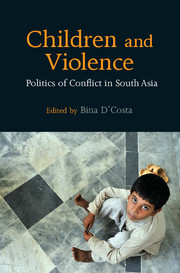Book contents
- Frontmatter
- Dedication
- Contents
- List of Map, Figures and Tables
- Acknowledgements
- Introduction: ‘Turtles Can Fly’: Vicarious Terror and the Child in South Asia
- Part I Shaping Childhood in South Asia
- Part II Conflict and Violent Peace
- Part III Rights, Needs and Protection
- Part IV Reflections from Human Rights Advocates in the Region
- 11 Being Young in a Time of Conflict: Kashmiri Youth and Children – A Reflection
- 12 The Killing of Youths in Sri Lanka: Historical Wrongs and the Failure of the State
- 13 The Impact of War and Violence on Young Minds
- Bibliography
- Notes on Contributors
- Index
13 - The Impact of War and Violence on Young Minds
from Part IV - Reflections from Human Rights Advocates in the Region
Published online by Cambridge University Press: 05 June 2016
- Frontmatter
- Dedication
- Contents
- List of Map, Figures and Tables
- Acknowledgements
- Introduction: ‘Turtles Can Fly’: Vicarious Terror and the Child in South Asia
- Part I Shaping Childhood in South Asia
- Part II Conflict and Violent Peace
- Part III Rights, Needs and Protection
- Part IV Reflections from Human Rights Advocates in the Region
- 11 Being Young in a Time of Conflict: Kashmiri Youth and Children – A Reflection
- 12 The Killing of Youths in Sri Lanka: Historical Wrongs and the Failure of the State
- 13 The Impact of War and Violence on Young Minds
- Bibliography
- Notes on Contributors
- Index
Summary
The author met Gulwareena in a makeshift camp in a school building on the outskirts of Bannu Town established for displaced people. In her local tribal Pashto dialect, the green-eyed seven year old Gulwareena narrates her experience of living with her parents in the North Waziristan Agency on the Pak-Afghan border: a scene of war and conflict for over a decade now. ‘I was always terrified by the loud sounds of shells, jets and fast planes,’ she says while raking her little fingers through her burgundy red uncombed hair. ‘My brothers would go out to watch but I would hide under the bed or under my mother's thick shawl. Days after periods of artillery shelling and bombing, I couldn't sleep.’ Gulwareena has vivid memories of the blood soaked bodies of her two young female cousins who became victims of a stray mortar shell while going to the local school in the dusty Miranshah village back in 2013 when she was only five years old. ‘I never went out to play after that incident,’ she remembered with a straight face, as if the fear of being killed has become a part of her everyday life.
Gulwareena is just one of the thousands of children who along with her family managed to reach the makeshift camp for displaced people at Bannu to avoid being caught in the cross fire after a massive military operation was launched in her native North Waziristan in June 2014. Children here have long been vulnerable and prone to the distressing effects of terrorism, whether in warzones in the tribal areas straddling the Pak-Afghan border or terrorist attacks in a busy and settled city like Peshawar. Exhausted by 18 hours journey by foot, she said she was happy to have reached Bannu and found shelter: ‘I am happy there are no jets or shelling anymore. I can even play here.’
Throughout history people have been seeing terrifying examples of the affects of war and conflict on communities. Such traumatic events certainly threaten the emotional and psychological wellbeing of children. Indeed, children and young people are often the most directly impacted by violence during periods of unrest and those who do manage to survive often struggle to live with the vivid and terrifying images of bloodshed for the rest of their lives.
- Type
- Chapter
- Information
- Children and ViolencePolitics of Conflict in South Asia, pp. 283 - 288Publisher: Cambridge University PressPrint publication year: 2016



